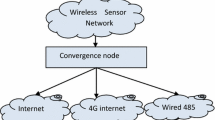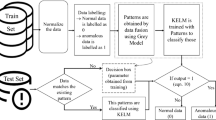Abstract
Special medical supplies such as blood and vaccines have strict temperature requirements in medical cold storage. In order to improve the stability of the temperature monitoring system in the medical cold storage and solve the problem of low measurement accuracy caused by node failure or abnormal data interference, we propose an algorithm based on classification adaptive estimation (CAEWF). The algorithm first monitors and classifies the data collected by the nodes, and uses the mutual support matrix between the data to filter out the validity abnormal data and transmit them to the cluster head. Then use the classification adaptive estimation weighted fusion algorithm to estimate the weighted fusion of the data. The simulation results show that the accuracy of the CAEWF algorithm is better than the arithmetic mean and batch estimation fusion algorithm, which can meet the temperature accuracy requirements of medical cold storage.





Similar content being viewed by others
Data Availability
Enquiries about data availability should be directed to the authors.
References
Tan, R., Xing, G., Liu, B., et al. (2012). Exploiting data fusion to improve the coverage of wireless sensor networks. IEEE/ACM Transactions on Networking, 20(2), 450–462.
Bulbul, A.A.-M., Jibon, R. H., Rahaman, H., Biswas, S., Hossain, M., & AbdulAwal, M. (2021). Application of WSN in smart grid: Present and future perspectives. International Journal of Sensors, Wireless Communications and Control, 11(6), 649–665.
Bhavatharangini, S., & Ramakrishnan, S. (2022). Reducing the internet traffic in IoT-based monitoring and control system through a combination of WSN and LoRaWAN networks. International Journal of Ad Hoc and Ubiquitous Computing, 39(4), 211–222.
Alsafasfeh, M., Arida, Z. A., Saraereh, O. A., Alsafasfeh, Q., & Alemaishat, S. (2021). An optimized data fusion paradigm for WSN based on neural networks. Computers, Materials & Continua, 69(1), 1097–1108.
Kumar, K. A., & Jayaraman, K. (2020). Irrigation control system-data gathering in WSN using IOT. International Journal of Communication Systems, 33(16), e4563.
Zhenguo, C., Liqin, T., & Chuang, L. (2017). Trust model of wireless sensor networks and its application in data fusion. Sensors, 17(4), 703.
Zhou, G., Xu, J. (2021). Application research of multi-sensor data fusion in factory intelligent control. Creativity and Innovation, 4(3)
Fang, Y., Jie, C., Yibing, L., et al. (2016). Decision-making algorithm for multisensor fusion based on grey relation and DS evidence theory. Journal of Sensors, 2016, 1–11.
Xiaoan, Yang, Jingjing, et al. (2010). Fast global optimization neural network and its application in datafusion. Journal of Physical Chemistry C, 114(11), 4887–4894.
Wang, Q., Liao, H., Wang, K., et al. (2011). A variable weight based fuzzy data fusion algorithm for WSN[C]// Ubiquitous intelligence and computing—8th international conference, UIC 2011, Banff, Canada, September 2–4, 2011. Proceedings. Springer.
Fanding, M., Aihua, Li., & Zhidong, L. (2022). An Evidence theory and data fusion based classification method for decision making. Procedia Computer Science, 199, 892–899.
Krishnamachari, B., & Iyengar, S. (2004). Distributed Bayesian algorithms for fault tolerant event region detection in wireless sensor networks. IEEE Transactions on Computers, 53(3), 241–250.
Atassi, A., Sayegh, N., Elhajj, I., et al. (2008). Malicious node detection in wireless sensor networks[C]// Spring simulation multiconference. Society for computer simulation international.
Funding
Key R&D Program in Shandong Province (2019GGX105001); Shandong University Science and Technology Plan Project (J18KB164,J18KB163); Qingdao Huanghai University Science and Technology Project (2021KJ08).
Author information
Authors and Affiliations
Corresponding author
Ethics declarations
Conflict of interest
The authors declare that there is no conflict of interest regarding the publication of this paper.
Additional information
Publisher's Note
Springer Nature remains neutral with regard to jurisdictional claims in published maps and institutional affiliations.
Rights and permissions
About this article
Cite this article
Yan, D., Liu, P., Yue, X. et al. Data Fusion Algorithm Based on Classification Adaptive Estimation Weighted Fusion in WSN. Wireless Pers Commun 127, 2859–2871 (2022). https://doi.org/10.1007/s11277-022-09900-x
Accepted:
Published:
Issue Date:
DOI: https://doi.org/10.1007/s11277-022-09900-x




